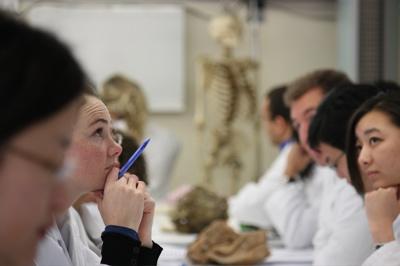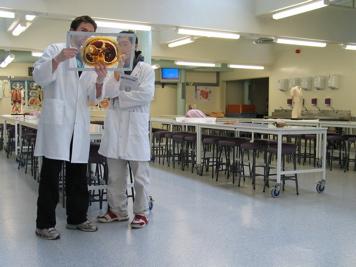Have you ever wondered what happened to a body once it was donated to the medical school? Have you ever wondered what it would be like to be a medical student and to take somebody apart to see how they worked? Now is your chance to find out, thanks to a film made in New Zealand.
 I'm a doctor and a film maker based in Dunedin, New Zealand. A few years ago I completed a film on organ donation. I looked at the process involved from the point of view of the donors, their families, those waiting for organs and the various medical staff who have to deal with the complex issues and attempt to balance the two sides of the story.
I'm a doctor and a film maker based in Dunedin, New Zealand. A few years ago I completed a film on organ donation. I looked at the process involved from the point of view of the donors, their families, those waiting for organs and the various medical staff who have to deal with the complex issues and attempt to balance the two sides of the story.
After I finished I realized that there was another powerful donation story, one that I had been involved with myself as a medical student 20 years earlier... that of the relationship between a medical student and the body they dissected.
The Otago Medical School is one of the few schools in the world where medical students still do significant human dissection. The development of plastination and 3D computer models, coupled with a shortage of cadavers in many countries, has led to a reduction in the amount of dissection performed by medical students in many countries, including the UK. Some medical schools no longer do any cadaver dissection, teaching anatomy just with models.
There has long been a feeling though, that students learn far more than just anatomy from doing dissection. The cadaver they work on can be seen as their first 'patient', teaching them about respect, humanity and helping them to distance themselves from the suffering of others, as they come to terms with their own mortality.
 Since the Alder Hay enquiry there's been a certain amount of disquiet amongst medical schools about revealing what goes on behind the doors of the dissection room. When I first approached Professor Helen Nicholson, the head of anatomy at my old school, I expected to get pretty short shrift. Luckily Helen had also just received a request from funeral directors involved in the bequest programme for more information for potential donors, to allow them to make a more informed consent regarding their bequest.
Since the Alder Hay enquiry there's been a certain amount of disquiet amongst medical schools about revealing what goes on behind the doors of the dissection room. When I first approached Professor Helen Nicholson, the head of anatomy at my old school, I expected to get pretty short shrift. Luckily Helen had also just received a request from funeral directors involved in the bequest programme for more information for potential donors, to allow them to make a more informed consent regarding their bequest.
It took some time to work through all of the issues with the medical school hierarchy, the examiner of anatomy, and the ethics committee, but eventually we had all of the permissions we needed. We contacted all the people in the area who were planning to donate their bodies for dissection, and received about fifty replies. Of those, two people who planned to donate their bodies also knew that they were dying. They generously agreed to be interviewed and to allow us to follow their bodies through the whole process. We interviewed these two men, and several other potential donors, and then waited. There's a strange sort of guilt in sitting and waiting for somebody to die, you sort of want them to... but also not at the same time. Eventually they did die and we were able to start filming.
On the first day of lectures we approached the new class and asked for volunteers. We interviewed them before they had ever been in the dissection room and arranged for those students to be working on our two cadavers. We were there when they met their body for the first time, we were there when they made the first cut, we were there when they took out the heart, the lungs and the brain and we were there two years later, when they said their final goodbyes.
The students were amazing. Over the two years they became comfortable with the cameras and skilled at expressing what they were thinking, feeling and experiencing. They talked about their hopes and their fears, what they were experiencing and how it was affecting them. There was an eerie similarity between what they were saying and what our donors had said a year earlier. It was at this point that we started to realize quite what a special film we had on our hands.
Despite the popularity of shows such as Von Hagens Bodyworlds (now officially the most popular touring exhibition ever) the subject needed to be handled with a certain amount of sensitivity... we weren't making Anatomy 101, we were making a film about the effect dissection has on students, donors and their families, and those donors were going to be recognizable and identifiable. I've never been so scared in my life as the day we had to play an early cut of the film to the relatives of the donors.
The whole journey was an amazing and slightly surreal experience, we knew these two men, we had interviewed these two men and we were now watching the students dissect these two men. It wasn't until one of the lecturers pointed out that we were probably the only people ever to be in this situation that I had an idea. I asked the students if they would like to 'meet' the people they had dissected, they all said yes, so after they had finished the course and said their goodbyes, we showed them the interviews with the live people they'd worked on. Some found it reassuring, some found it upsetting, all found it a profound experience and it gives the film an emotional climax you would be hard to match in any drama, a climax made even more powerful by the fact that it is real.
It was an honour to be allowed to share the journey of these amazing people and as one of the students said, one that will stay with me for the rest of my life.
If you'd like to know more go to
www.prnfilms.co.nz










Comments
Add a comment